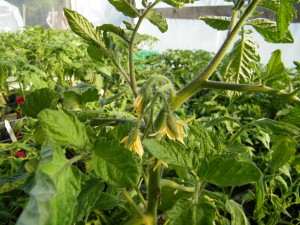It’s too bad these pages don’t have a scratch-and-sniff feature. If they did, you’d be able to huff that warm, oxygen-rich smell of tomato plant leaves. I inhale that incredible smell every time I peek into one of our seedling greenhouses, where thousands of infant tomato plants reach up to bask in the May sunshine.
 If you haven’t sniffed a tomato plant yet this year, promise me you’ll make the time to stop and smell the foliage next time you come across a tomato plant at the farmers market or nursery. Gently brush the plant’s leaves, then lean in and inhale. You’ll find that many varieties smell slightly different: some are citrusy, others earthy.
If you haven’t sniffed a tomato plant yet this year, promise me you’ll make the time to stop and smell the foliage next time you come across a tomato plant at the farmers market or nursery. Gently brush the plant’s leaves, then lean in and inhale. You’ll find that many varieties smell slightly different: some are citrusy, others earthy.
For a truly decadent smelling experience, mark Sunday, May 18 on your calendar: it’s Makaria Farm’s 6th annual organic tomato plant (and veggie seedling) sale from 10am to 1pm.
You’re also welcome to sniff tomato plants at our Duncan Farmers Market booth throughout May and early June. In addition to great smelling, healthy plants, we’re happy to share growing tips and tricks.
Tip to prevent transplant shock:
It might seem easiest to dig a hole and stick your tomato plant in it, but if you do this you risk exposing the plant to the chillier soil underneath that sun-warmed top layer. Tomato plants may turn blue/purple-ish as a result — a sign of transplant shock. They will take longer to recover, which may affect the time or quality of your tomato harvest.
Many tomato plants are vines (“indeterminate”), so here’s a quick tip on transplanting vining tomato plants: lay each tomato in its place horizontally on the garden bed, then cover the rootball with soil from the warm top layer of the garden bed surrounding it. Carefully but firmly pat down the dirt to ensure plant/soil contact, then water the root area thoroughly. Eventually, the tomato plant will turn up toward the sun.
